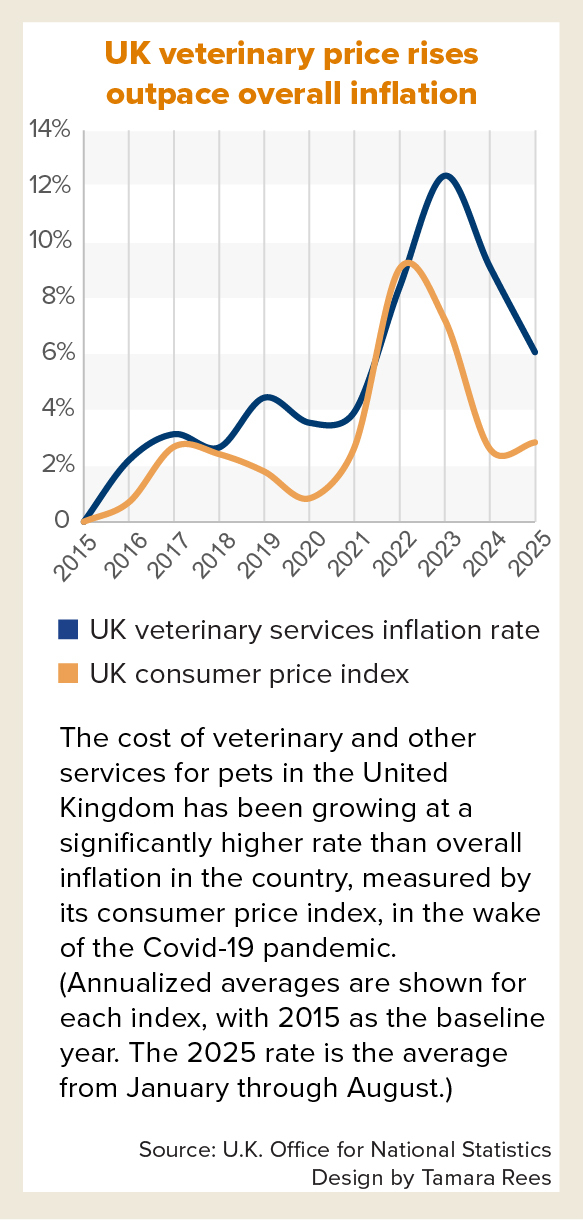- Weekend Rounds
- Posts
- UK Regulators Target the Veterinary Industry
UK Regulators Target the Veterinary Industry
Plus: Pet obesity and retaining techs
Hello 👋
Welcome back to another edition of Weekend Rounds! Did you forget to go big for National Veterinary Technician Week? Same…
But don’t worry because appreciation is timeless. Stock the break room, scribble a thank-you on every kennel card, and let your techs hear the words “we couldn’t do this without you” at least three times a day. Make-up week starts… now.
Here’s what we’re covering:
🔬 UK Vet sector under microscope
🐶 Pet Obesity Resources
👩⚕️ Wrapping up National Technician Week
🚀 Quick hits

🔬
UK’s Vet Sector Under the Microscope: Price Caps, Published Lists & Pet Owner Rights
Pet owners in the UK might soon see radical transparency when they visit their vet clinic. The Competition and Markets Authority (CMA) has released provisional reforms targeting the nation’s £6.3 billion veterinary services sector. We’ve covered this before and promised updates when it was through. The result is not a light nudge. The proposed changes include requiring practices to publish full price lists, limiting prescription charges (a suggested cap of £16 per written prescription), mandating itemized bills for larger cases, and launching a centralized vet price comparison platform.
The CMA’s investigation found that prices in the veterinary sector have climbed ~63% between 2016 and 2023, which is greatly above inflation. Plus, they found that pet owners often pay 16–17% more at large corporate veterinary groups than at independent clinics.
The reforms aim to rebalance consumer power, reduce opaque pricing practices, and rein in what critics see as profiteering in what many consider an essential sector.
For veterinary practices, the implications could be profound. Larger groups may face pressure to recalibrate pricing strategies or absorb margin compression; whereas small clinics may benefit from increased consumer trust if their pricing is already competitive. The requirement to disclose ownership status also shines a light on consolidation trends in the industry. Regulatory change is never painless, but these proposals may lead clinics to reassess their transparency, client communication, and competitive positioning.
You can read more on VIN News:
🐶
Pet Obesity Gets a Remix: Survey Launch, Tools Shared, and Veterinary Role Amplified
Animal hips are creaking—and veterinary teams are stepping into the ring. Last week saw the launch of the 2025 Pet Obesity & Nutrition Opinion Survey, backed by the Association for Pet Obesity Prevention (APOP) and the World Pet Obesity Association (WPOA). The survey, open through December, is collecting perspectives from both veterinary professionals and pet owners on nutritional management, weight stigma, and barriers to discussing obesity.
Coinciding with World Pet Obesity Week (Oct 6–12), APOP and WPOA rolled out a complimentary toolkit: breed‑specific feeding calculators, stepwise weight‑loss plans, multilingual body condition scoring charts, and client education materials designed to reduce stigma and foster collaborative weight discussions. Their guidance emphasizes pet‑first language, nonjudgmental framing, and structured client communication approaches to navigate a topic steeped in sensitivity.
The problem isn’t theoretical: earlier surveys estimated that ~61% of cats and 59% of dogs are overweight or obese, and less than half of practitioners routinely discuss weight during annual exams. With obesity’s ripple effects on osteoarthritis, cardiopulmonary disease, endocrinopathies, and quality of life, veterinary teams are being nudged to more deliberately integrate weight management into wellness workflows. This is your moment: leverage the new tools, train staff in empathetic conversations, track BCS changes over time, and make “healthy weight” a core metric in preventive care.

👩⚕️
Understanding Retention Factors Among Technicians
Veterinary technicians are the backbone of clinical teams—and the attrition numbers tell a troubling story. AAHA’s recent Stay, Please retention analysis (which draws from 2023–2024 surveys) delved deeply into the drivers behind why credentialed technicians stay or leave.
The study found that many of the factors technicians deem most critical (career progression, respect, recognition, scheduling flexibility) are also the ones most frequently unmet. In other words, the deal-breakers are not just about pay — they’re about alignment between expectations and reality. The gap between ideal and actual experience was widest in smaller practices, where technicians reported fewer formal development pathways, less visibility, and limited internal mobility.
This insight matters now more than ever: during National Veterinary Technician Week (Oct 12–18), clinics are spotlighting techs’ roles, but the celebrations should extend into strategic change. dvm360 emphasizes this in their wrap-up of tech week, including stories about technician advocacy, career options, and visibility.
If you lead a practice, here are practical considerations: conduct exit interviews with technicians, map career ladders or specialization pathways, audit scheduling fairness, and invest in emotional support or grief processing resources. Recognize and reward tech contributions beyond the exam room.
🚀
Quick Hits
Here are some of the other stories that caught our eye and we're following this week from around the veterinary world and animal kingdom:
How did we do today?Tell us what you thought of this edition of Weekend Rounds so we can keep improving! |

